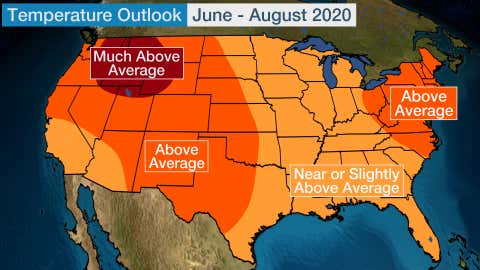
Flash Floods Swamp Roads, Homes
A hotter-than-average summer is anticipated across most of the contiguous United States, according to the latest outlook issued by The Weather Company, an IBM Business.
The Northeast and mid-Atlantic can generally expect above-average temperatures from June through August. Above-average temperatures will also extend from Central Texas into the Pacific Northwest. Temperatures will be much above average from eastern Washington and eastern Oregon into Idaho, western Montana, western Wyoming, northern Utah and northeastern Nevada this summer.
Areas from the Gulf Coast into the Midwest and upper Mississippi Valley, as well as in Southern California, southern Nevada and southwestern Arizona, may have temperatures near average or slightly warmer during the summer months.

One factor that suggests it will be a hot summer for most of the U.S. is sea-surface temperature changes that are expected to develop in the equatorial tropical Pacific Ocean.
Water temperatures in the equatorial tropical Pacific are monitored for indications of a developing El Niño or La Niña. ENSO-neutral conditions, meaning neither El Niño nor La Niña, are currently present.
Some cooling in the tropical Pacific has recently been observed, while sea-surface temperatures in the Indian Ocean and areas near Indonesia have had warming, as highlighted in the graphic below. Computer models suggest this trend may continue into the summer, which may lead to La Niña conditions developing later this year. As a reminder, La Niña occurs when the equatorial eastern and central Pacific Ocean is cooler than average by at least 0.5 degrees Celsius (0.9 degrees Fahrenheit), along with consistent atmospheric indications.
A hot summer is often observed in the U.S. when a shift toward La Niña occurs.
"Historically, some of our hottest summers have come during La Niña transitions, including 2005, 2010 and 2016," said Dr. Todd Crawford, chief meteorologist at The Weather Company.

Climate models also suggest an unusually warm summer, especially across the West and Northeast, which is reflected in this outlook.
One piece of the puzzle that could limit some of the heat is soil moisture, which remains high, particularly across the Northern and Central Plains. Soil moisture can have an impact on local weather patterns and often signals cooler conditions.
However, Crawford said that the historic levels of last spring's rainfall in the Plains are not expected, and a slightly warmer outcome is anticipated across the Plains this year compared to last summer.
Here's a closer look at what to expect month by month from May through August.
May 2020
The last month of spring will have temperatures near average or slightly warmer from the Northeast and mid-Atlantic into the Midwest, as well as along the West Coast. Above-average temperatures are expected to stretch from the Southeast into the Southern Plains and the interior West.
Meanwhile, the upper-level pattern will likely bring cooler temperatures to portions of northern North Dakota and northern Minnesota. There is a chance that May might be cooler than the current forecast, especially across parts of the northern tier.
(MORE: When the Last Freeze of the Season Typically Occurs)

June 2020
Most areas east of the Mississippi River are expected to experience temperatures near average or slightly warmer as summer begins. The exception will be the Florida Peninsula, which may continue to trend above average.
(MORE: 2020 Is Miami's Hottest Year So Far)
Most of the West will have above-average temperatures, with temperatures the farthest above average from central Washington into central Montana and southward into northeastern Arizona and northwestern New Mexico.

July 2020
The one area of the Lower 48 that may trend near average to slightly cooler will be from far Southern California into southwestern Arizona.
Otherwise, much of California and the Southwest, as well as areas from the upper Midwest into the South, will have temperatures near average or slightly warmer.
Above-average temperatures are expected for the Northeast and mid-Atlantic, as well as from the western High Plains into the Northwest, with much-above-average temperatures from Washington into central Montana and northwestern Wyoming.

August 2020
Most of the Lower 48 will likely have above-average conditions as the summer ends. Temperatures will be the farthest above average in parts of the Northwest.
A few areas may trend near average or slightly warmer. This includes locations near the Gulf Coast and into the lower Mississippi Valley, as well as the north-central U.S. and parts of the Southwest.

The Weather Company’s primary journalistic mission is to report on breaking weather news, the environment and the importance of science to our lives. This story does not necessarily represent the position of our parent company, IBM.



